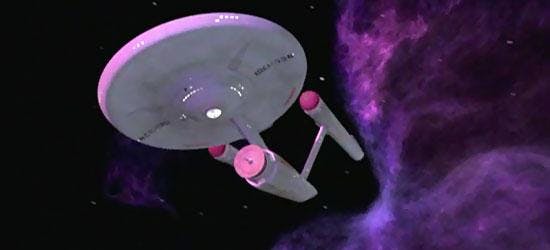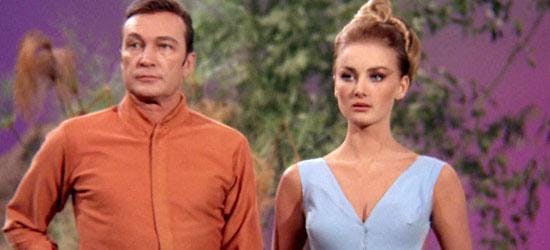Published Jun 10, 2014
ONE TREK MIND: The Galactic Barrier
ONE TREK MIND: The Galactic Barrier

Here on Earth, and in our time period of relative medievalism (thanks for the insult, Dr. McCoy), we sometimes complain about “hitting the wall.” But the exhaustion from work, commuting and dealing with parents who are trying to figure out how to use digital cameras (“are my pictures in the cloud now?”) is nothing compared to when our friends aboard the USS Enterprise hit the wall. We can always pour ourselves a glass of wine at the end of the day – but the Galactic Barrier is something else entirely.

A reminder about the vastness of space: the bulk of Star Trek's adventures don't even leave our galaxy. (And, if you are rusty on your Carl Sagan or Neil deGrasse Tyson, our Milky Way is one of just billions and billions.) Not only does the Federation tend to stick close to home, we're usually in our li'l corner of the Alpha Quadrant close to the border of the Beta Quadrant. Not until the Wormhole spat us into the Gamma or the Caretaker slingshot us into the Delta did we get too involved in those far-flung places. (And a good thing, too, because for every friendly Neelix there were 20 species in both zones who just wanted to kill kill kill.)

We don't really know for certain what intergalactic space will be like, but science is always on the hunt. It is theorized that the area between galaxies, knows as Voids, is made of highly ionized hydrogen at a temperature known as WHIM – which stands for Warm-Hot Intergalactic Medium. More relevant to our discussion, the boundaries to these Voids are believed to be organized in a rarefied plasma known as the Galactic Filament Structure. These structures are out there, at the edges of galaxies, and in 2006 a huge mass was discovered, said to be the largest thing yet known to humanity. These … things… have the most fantastic name you could ever dream of: Lyman-alpha blobs. The 2006 discovery, specifically, is known as the Newfound Blob. Beware the blob!
When Samuel Peeples turned in his draft of “Where No Man Has Gone Before” back in the mid 1960s there wasn't much talk of Lyman-alpha blobs. (Heck, the term Black Hole was barely known then.) But he posited that some sort of something would contain our galaxy, and crossing its transom meant trouble.

To the Enterprise, following the trail of the missing SS Valiant, it meant a surge of energy that, for reasons that were never quite understood, were hazardous to crewmembers that had a high proclivity toward extra sensory perception. Alas, this spelled eventual doom for Captain Kirk's longtime wingman Gary Mitchell, whose esper rating was elevated enough that he ended up getting silvery eyes and an echoey voice. (And knew when Spock was spying on him with a view screen – creeeeepy!)

The barrier also did severe damage to the ship's engines and shields, and we later learned that this was due to the concentration of negative energy that the field contained. The Kelvans from the Andromeda Galaxy, whom we meet in the episode “By Any Other Name,” are the first trans-galactic creatures that cross Kirk's path, and they've had a pretty rough go getting through. (The way Kirk annoyingly barks “yes, I know, we've been there!” when the Kelvan captain tries to describe the barrier is among my favorite William Shatner moments of all time.) The negative energy blocks any communication and did major damage to the generation ships that came from Andromeda (hence, the need to shanghai the Enterprise.)
There were moments here and there in TNG and elsewhere that we caught a glimpse outside our Milky Way, but they are fairly downplayed. But who really knows where they went with The Traveller in “Where No One Has Gone Before?” And if Tom Paris went beyond Warp 10 that one time, well . . .maybe we shouldn't even bring “Trespass” up.

In the Q-Continuum novels, the Galactic Barrier is revealed to be a creation of the Continuum used to keep a being known as “0” out of town, and the psionic qualities of a Q sentry contained therein are, therefore, what causes a fuss to the Gary Mitchells of the world. Reg Barclay is able to use the Enterprise E's bio-neural gel packs to tap into this essence at some point, which sounds like a neat trick. (I gotta confess, I dig Greg Cox's books, but haven't gotten around to these just yet.)
Let me ask you, do you feel more secure knowing a Galactic Barrier is surrounding us here in the Milky Way, or are you penned in and yearning to breathe free? Tell us your thoughts in the comments below. You'll need to type, as my esper count is quite low and I can't tell what you are thinking.
Jordan Hoffman is a writer, critic and lapsed filmmaker living in New York City. His work can also be seen on Film.com, ScreenCrush and Badass Digest. On his BLOG, Jordan has reviewed all 727 Trek episodes and films, most of the comics and some of the novels.

